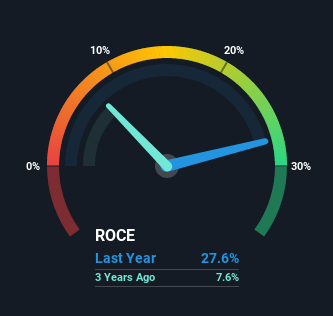Investors Should Be Encouraged By Ingersoll-Rand (India)'s (NSE:INGERRAND) Returns On Capital

If you're looking for a multi-bagger, there's a few things to keep an eye out for. One common approach is to try and find a company with returns on capital employed (ROCE) that are increasing, in conjunction with a growing amount of capital employed. Put simply, these types of businesses are compounding machines, meaning they are continually reinvesting their earnings at ever-higher rates of return. With that in mind, the ROCE of Ingersoll-Rand (India) (NSE:INGERRAND) looks great, so lets see what the trend can tell us.
Understanding Return On Capital Employed (ROCE)
Just to clarify if you're unsure, ROCE is a metric for evaluating how much pre-tax income (in percentage terms) a company earns on the capital invested in its business. Analysts use this formula to calculate it for Ingersoll-Rand (India):
Return on Capital Employed = Earnings Before Interest and Tax (EBIT) ÷ (Total Assets - Current Liabilities)
0.28 = ₹1.3b ÷ (₹6.7b - ₹2.1b) (Based on the trailing twelve months to June 2021).
So, Ingersoll-Rand (India) has an ROCE of 28%. That's a fantastic return and not only that, it outpaces the average of 14% earned by companies in a similar industry.
View our latest analysis for Ingersoll-Rand (India)

Historical performance is a great place to start when researching a stock so above you can see the gauge for Ingersoll-Rand (India)'s ROCE against it's prior returns. If you're interested in investigating Ingersoll-Rand (India)'s past further, check out this free graph of past earnings, revenue and cash flow.
The Trend Of ROCE
You'd find it hard not to be impressed with the ROCE trend at Ingersoll-Rand (India). The data shows that returns on capital have increased by 553% over the trailing five years. That's not bad because this tells for every dollar invested (capital employed), the company is increasing the amount earned from that dollar. Speaking of capital employed, the company is actually utilizing 54% less than it was five years ago, which can be indicative of a business that's improving its efficiency. If this trend continues, the business might be getting more efficient but it's shrinking in terms of total assets.
On a side note, we noticed that the improvement in ROCE appears to be partly fueled by an increase in current liabilities. Effectively this means that suppliers or short-term creditors are now funding 31% of the business, which is more than it was five years ago. Keep an eye out for future increases because when the ratio of current liabilities to total assets gets particularly high, this can introduce some new risks for the business.
What We Can Learn From Ingersoll-Rand (India)'s ROCE
In the end, Ingersoll-Rand (India) has proven it's capital allocation skills are good with those higher returns from less amount of capital. Since the stock has returned a staggering 168% to shareholders over the last five years, it looks like investors are recognizing these changes. With that being said, we still think the promising fundamentals mean the company deserves some further due diligence.
Like most companies, Ingersoll-Rand (India) does come with some risks, and we've found 1 warning sign that you should be aware of.
Ingersoll-Rand (India) is not the only stock earning high returns. If you'd like to see more, check out our free list of companies earning high returns on equity with solid fundamentals.
New: AI Stock Screener & Alerts
Our new AI Stock Screener scans the market every day to uncover opportunities.
• Dividend Powerhouses (3%+ Yield)
• Undervalued Small Caps with Insider Buying
• High growth Tech and AI Companies
Or build your own from over 50 metrics.
This article by Simply Wall St is general in nature. We provide commentary based on historical data and analyst forecasts only using an unbiased methodology and our articles are not intended to be financial advice. It does not constitute a recommendation to buy or sell any stock, and does not take account of your objectives, or your financial situation. We aim to bring you long-term focused analysis driven by fundamental data. Note that our analysis may not factor in the latest price-sensitive company announcements or qualitative material. Simply Wall St has no position in any stocks mentioned.
Have feedback on this article? Concerned about the content? Get in touch with us directly. Alternatively, email editorial-team (at) simplywallst.com.
About NSEI:INGERRAND
Ingersoll-Rand (India)
Manufactures and sells industrial air compressors in India.
Flawless balance sheet with solid track record.
Market Insights
Community Narratives



